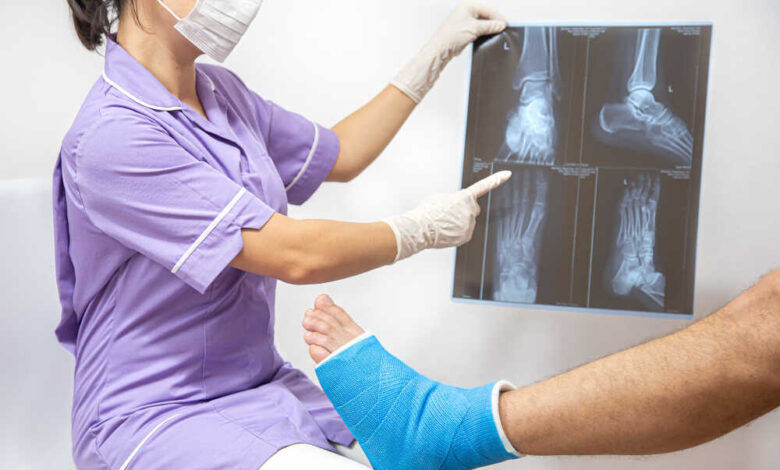Understanding Bone Fractures – Causes and Symptoms

Having a broken bone is indeed a bad experience for everyone. Although we all wish for our lives to go as smoothly as possible, unpleasant things take place unexpectedly.
However, these days, all bone fractures are treatable without much trouble thanks to advancements in the medical field.
Here, we are going to talk about all the ways that might happen to break your bones or joints along with symptoms after the injury and causes.
Types of Bone Fractures
There are many types of bone breaks as per how a fracture looks, its cause, and even the trauma that has damaged the bone. So, let’s explore all of them here.
Classification Based on Displacement
Displaced Breaks: It is a fracture where the bone isn’t just broken but has also moved further away from its usual place.
Non-Displaced Breaks: If a bone breaks without displacement or moving anywhere from its normal position, it is a fracture without displacement. This type of break is less severe than the previous one.
Closed Breaks: Here, your bone is broken but your skin is intact. Sometimes, a bone breaks or cracks without wounding the skin nearby.
Open Breaks: An open bone fracture is where a traumatised bone has not just broken but has also affected the nearby skin exacerbating the situation. Such cases of bone breaks take a long time to heal.
If you are dealing with joint pains, it could be an old case of fracture you might have left unnoticed for some reason. For medical advice here, try to connect to the best joint pain doctor near me. It will help detect underlying cases of fractures if any.
Other Forms of Fractures
Avulsion Fractures: It often happens to joints that are complicated in their composition and employ several connective tissues like ligaments or tendons.
It is a case of fracture where the bone in place has been disturbed and thus moved off its real position because of the fact that connective tissues attached to the bone like ligaments or tendons have been first either damaged or ripped as a result of acute external trauma or force.
For example, you might get this fracture on your knee or hands after getting involved in a road accident.
Impacted Fractures: It is a complicated form of bone fracture as the broken ends are stuck together reluctant to move in the desired direction.
Comminuted: When your fractured bone has broken ends that are further damaged into several pieces, it is a case of comminuted fracture.
Compression: This type of fracture is related to your backbone. Compression fractures happen in vertebrae. When, as a result of getting older or deficiency of calcium, small breaks in the vertebrae occur, these breaks are known as compression fractures.
Greenstick: Sometimes, a bone just breaks partially only affecting one of its sides. This is known as greenstick fracture. It is usually a result of mild trauma or timely rescue of the part involved in trauma.
Oblique: It is a break that goes through the affected bone diagonally at some angle. If left unattended, this fracture can even get displaced because of angularity.
Spiral: All the bone breaks that occur in a spiral way are categorised as spiral fractures. The involvement of a twisting motion in the way a break runs through a bone is what gives it this name.
Transverse: If you happen to have a bone break that looks like a straight horizontal line through the affected segment of a bone, it is called a transverse bone fracture.
Causes
Normally, you have a bone fracture after hitting yourself somewhere so hard that it is more than a bone can tolerate. Consider the following common scenarios conducive to causing a bone break.
- Knocking yourself down while running;
- Getting involved in a road accident riding a bike;
- Falling while going downstairs, etc.
In short, almost any force hitting a bone might result in a fracture. The only condition is that the trauma involved has to be more intense than the bone can tolerate.
Normally, bones are resilient and they can thus bear minor unexpected falls without any trouble.
Often, when people have joint problems, they take it lightly. It makes the situation worse and eventually, it leads to the point where surgery is the only option.
In case you need a knee implant, make sure you first find the best knee replacement hospital in Delhi or wherever you live.
You must arrange for the best doctor and medical facilities before saying yes to any orthopaedic treatments involving implants.
Symptoms: how to know if you have a bone fracture
During bone breaks, you will encounter the following symptoms. You might have all or some of them.
Pain: This is the most common thing in all types of fractures. You will feel the affected area tender, swollen and painful.
Swelling: If you have a bone fracture, it will get swollen and hurt very much. It is a natural process called inflammation.
When part of the body gets injured, it becomes red, painful and bigger than normal. It happens because your body has its built-in mechanism called the immune system to heal itself.
Tenderness: Your skin becomes tender and hurts when you touch it. Usually, all the symptoms of pain, swelling and tenderness (or inflammation) go hand in hand.
Discolouration: Another thing you will notice is discolouration: the skin over the affected area will change its colour usually turning into some dark pigmentation. It often happens sometime after the occurrence of internal injuries.
Protrusion: It is the most crucial factor and it will not go unnoticed. When you have a bad fracture, it protrudes.
Suppose your arm is broken into two. In that case, it will look distorted enough to give you the impression of sticking out – a crucial symptom in the cases of bad fractures.
Immobility: Not being able to move an affected part after a fracture is another thing. You will be immobile for a while. It will hurt to move it about.
All these symptoms usually occur simultaneously. Don’t take it lightly if the possibly broken part hurts and you cannot move it. Seek immediate medical attention.
Visit Here mrtechmagazine.com for more blogs




